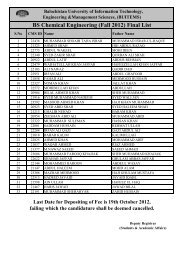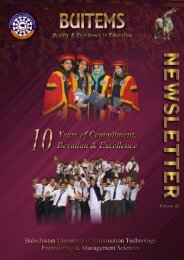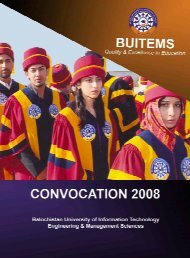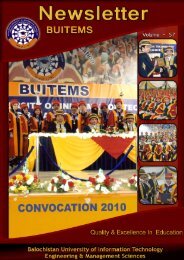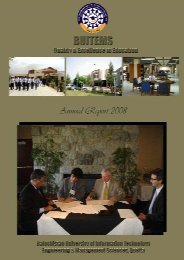BUITEMS
Research Journal - buitems
Research Journal - buitems
- No tags were found...
You also want an ePaper? Increase the reach of your titles
YUMPU automatically turns print PDFs into web optimized ePapers that Google loves.
<strong>BUITEMS</strong><br />
Quality & Excellence in Education<br />
Comparative Genome/Proteome Analysis of Four Serotypes of Dengue Virus Using Bioinformatics Tools<br />
Positively charged and negatively charged<br />
amino acid residues were also calculated for<br />
dengue virus and comparison was made<br />
among the four serotypes. DENV2<br />
contained the highest number of both<br />
positively and negatively charged residues<br />
followed by DENV4. Figure1 shows the<br />
detailed results.<br />
Fig 1. Comparative analysis of Dengue<br />
Serotypes in respect of variation in number of<br />
negatively and positively charged amino acids<br />
Dengue protein subcellular localization in<br />
the host cell<br />
Virus-mPLoc: is a freely available on line tool<br />
and is extensively used to predict the<br />
subcellular localization of viral proteins within<br />
host and virus-infected cells (Shen and Chou<br />
2010). The same tool was used to putatively<br />
know the sub cellular localization of capsid,<br />
envelop and membrane glycoproteins of all<br />
four serotypes of dengue virus. Results are<br />
summarized in the following table.<br />
Table 3: Putative location of Dengue<br />
structural proteins in the host<br />
All structural proteins of all serotypes of<br />
dengue virus are predicted to be localized in<br />
the Endoplasmic reticulum of the host. As<br />
far as amino acid length of these proteins is<br />
concerned, no difference was recorded for<br />
each of the three protein types among the<br />
serotypes except for capsid protein of DENV4<br />
which was 115 amino acid long as compared<br />
to 100 for the rest of three dengue types.<br />
DISCUSSION<br />
The main focus of this work was to predict<br />
with the help of bioinformatics tools the<br />
sub-cellular localization of different dengue<br />
proteins in the host. Not only the prediction<br />
was made for all three structural proteins but<br />
also a comparative analysis was made<br />
among Dengue serotypes. Surprisingly all<br />
structural proteins belonging to all four<br />
serotypes were predicted to be localized in<br />
the Endoplasmic reticulum of the host cell. In<br />
a previous such work these proteins were<br />
predicted to be localized in the host plasma<br />
membrane(Somvanshi and Seth 2009). The<br />
discrepancy probably is due to usage of<br />
different versions of the same tool that is<br />
Virus ploc and its improved Virus mploc<br />
version. As the later was used in this study,<br />
we expect more sensitivity. As far as physical<br />
and chemical parameters of the amino acid<br />
sequences is concerned, DENV2 manifested<br />
the highest molecular weight, highest pi and<br />
largest sequence length showing the<br />
interdependency of these characters on each<br />
other. This is in addition to the highest<br />
number of both positively and negatively<br />
charged amino acids for the same serotype.<br />
Among all four serotypes, DENV-4 was<br />
observed with relatively high percentage of<br />
GC content i.e. 47.1% which indicates that<br />
the genome of this serotype is more stable<br />
as compared to other serotypes due to the<br />
increased percentage of hydrogen bonds<br />
between G and C nucleotides. Therefore, this<br />
serotype is thermally more stable and high<br />
energy is required in order to denature its<br />
genome as compare to other serotypes.<br />
Contrary to this, the genome of DENV-2 is<br />
least thermally stable and cannot tolerate<br />
high temperatures and pressures as<br />
compared to other three serotypes as its<br />
genome contains the less GC content i.e.<br />
45.8%.<br />
23



